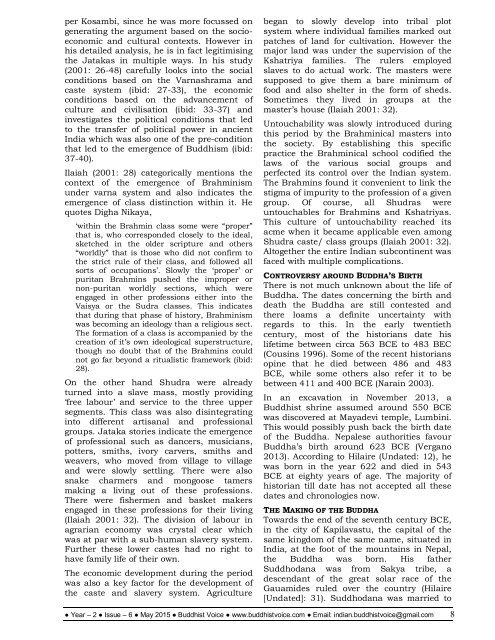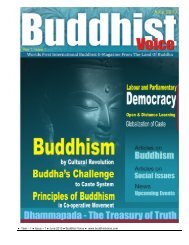BV - May 2015 Yr 2 Issue 6 E
You also want an ePaper? Increase the reach of your titles
YUMPU automatically turns print PDFs into web optimized ePapers that Google loves.
per Kosambi, since he was more focussed on<br />
generating the argument based on the socioeconomic<br />
and cultural contexts. However in<br />
his detailed analysis, he is in fact legitimising<br />
the Jatakas in multiple ways. In his study<br />
(2001: 26-48) carefully looks into the social<br />
conditions based on the Varnashrama and<br />
caste system (ibid: 27-33), the economic<br />
conditions based on the advancement of<br />
culture and civilisation (ibid: 33-37) and<br />
investigates the political conditions that led<br />
to the transfer of political power in ancient<br />
India which was also one of the pre-condition<br />
that led to the emergence of Buddhism (ibid:<br />
37-40).<br />
Ilaiah (2001: 28) categorically mentions the<br />
context of the emergence of Brahminism<br />
under varna system and also indicates the<br />
emergence of class distinction within it. He<br />
quotes Digha Nikaya,<br />
‘within the Brahmin class some were “proper”<br />
that is, who corresponded closely to the ideal,<br />
sketched in the older scripture and others<br />
“worldly” that is those who did not confirm to<br />
the strict rule of their class, and followed all<br />
sorts of occupations’. Slowly the ‘proper’ or<br />
puritan Brahmins pushed the improper or<br />
non-puritan worldly sections, which were<br />
engaged in other professions either into the<br />
Vaisya or the Sudra classes. This indicates<br />
that during that phase of history, Brahminism<br />
was becoming an ideology than a religious sect.<br />
The formation of a class is accompanied by the<br />
creation of it’s own ideological superstructure,<br />
though no doubt that of the Brahmins could<br />
not go far beyond a ritualistic framework (ibid:<br />
28).<br />
On the other hand Shudra were already<br />
turned into a slave mass, mostly providing<br />
‘free labour’ and service to the three upper<br />
segments. This class was also disintegrating<br />
into different artisanal and professional<br />
groups. Jataka stories indicate the emergence<br />
of professional such as dancers, musicians,<br />
potters, smiths, ivory carvers, smiths and<br />
weavers, who moved from village to village<br />
and were slowly settling. There were also<br />
snake charmers and mongoose tamers<br />
making a living out of these professions.<br />
There were fishermen and basket makers<br />
engaged in these professions for their living<br />
(Ilaiah 2001: 32). The division of labour in<br />
agrarian economy was crystal clear which<br />
was at par with a sub-human slavery system.<br />
Further these lower castes had no right to<br />
have family life of their own.<br />
The economic development during the period<br />
was also a key factor for the development of<br />
the caste and slavery system. Agriculture<br />
began to slowly develop into tribal plot<br />
system where individual families marked out<br />
patches of land for cultivation. However the<br />
major land was under the supervision of the<br />
Kshatriya families. The rulers employed<br />
slaves to do actual work. The masters were<br />
supposed to give them a bare minimum of<br />
food and also shelter in the form of sheds.<br />
Sometimes they lived in groups at the<br />
master’s house (Ilaiah 2001: 32).<br />
Untouchability was slowly introduced during<br />
this period by the Brahminical masters into<br />
the society. By establishing this specific<br />
practice the Brahminical school codified the<br />
laws of the various social groups and<br />
perfected its control over the Indian system.<br />
The Brahmins found it convenient to link the<br />
stigma of impurity to the profession of a given<br />
group. Of course, all Shudras were<br />
untouchables for Brahmins and Kshatriyas.<br />
This culture of untouchability reached its<br />
acme when it became applicable even among<br />
Shudra caste/ class groups (Ilaiah 2001: 32).<br />
Altogether the entire Indian subcontinent was<br />
faced with multiple complications.<br />
CONTROVERSY AROUND BUDDHA’S BIRTH<br />
There is not much unknown about the life of<br />
Buddha. The dates concerning the birth and<br />
death the Buddha are still contested and<br />
there loams a definite uncertainty with<br />
regards to this. In the early twentieth<br />
century, most of the historians date his<br />
lifetime between circa 563 BCE to 483 BEC<br />
(Cousins 1996). Some of the recent historians<br />
opine that he died between 486 and 483<br />
BCE, while some others also refer it to be<br />
between 411 and 400 BCE (Narain 2003).<br />
In an excavation in November 2013, a<br />
Buddhist shrine assumed around 550 BCE<br />
was discovered at <strong>May</strong>adevi temple, Lumbini.<br />
This would possibly push back the birth date<br />
of the Buddha. Nepalese authorities favour<br />
Buddha’s birth around 623 BCE (Vergano<br />
2013). According to Hilaire (Undated: 12), he<br />
was born in the year 622 and died in 543<br />
BCE at eighty years of age. The majority of<br />
historian till date has not accepted all these<br />
dates and chronologies now.<br />
THE MAKING OF THE BUDDHA<br />
Towards the end of the seventh century BCE,<br />
in the city of Kapilavastu, the capital of the<br />
same kingdom of the same name, situated in<br />
India, at the foot of the mountains in Nepal,<br />
the Buddha was born. His father<br />
Suddhodana was from Sakya tribe, a<br />
descendant of the great solar race of the<br />
Gauamides ruled over the country (Hilaire<br />
[Undated]: 31). Suddhodana was married to<br />
● Year – 2 ● <strong>Issue</strong> – 6 ● <strong>May</strong> <strong>2015</strong> ● Buddhist Voice ● www.buddhistvoice.com ● Email: indian.buddhistvoice@gmail.com 8



